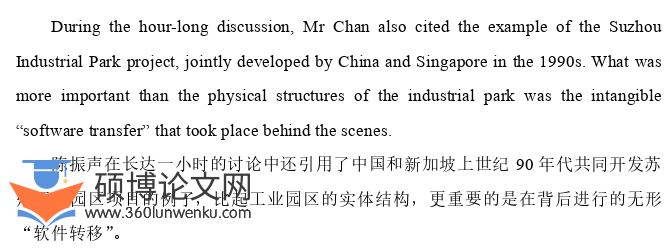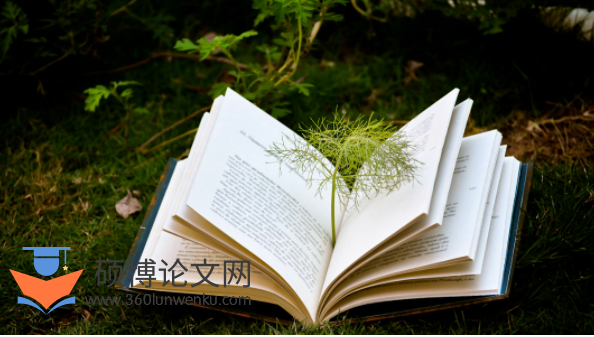本文是一篇英语论文,本报告阐释了在翻译过程中遇到的词法、句法和语篇上的困难,并以奈达的功能对等理论为指导得出解决方案。本报告旨在丰富新闻文本的汉译研究,更好地为中新两国交流合作作出贡献。
Chapter One Introduction
1.1Background and Significance
China’s Belt and Road Initiative (BRI), formerly known as One Belt One Road (OBOR), was launched in 2013 by President Xi Jinping. Revolving around five major priorities, infrastructure connectivity, unimpeded trade, financial integration, policy coordination and connecting people, the BRI has become China’s foremost diplomatic and economic policyin engaging with neighboring countries and beyond since 2013 (Zhao, 2020). Singapore has been a strong supporter and an active participant in the initiative, and is believed to be a key link especially for the Maritime Silk Road. In 2020, among the 64 countries along the Belt and Road, Singapore accounts for over 90% of the total investment made in China, while China’s investment in Singapore accounts for 35% of its overall investment made in countries along the Belt and Road (Investment Guide, 2022). As a major center of global and regional finance, approximately 60% of infrastructure projects in Southeast Asia obtain their finance and advisory services from Singapore-based financial institutions (Liu et al, 2021). Furthermore, Singapore offers a neutral third-party venue for Belt and Road countries and companies to resolve commercial disputes.
The Straits Times is a renowned, English-language daily broadsheet newspaper that has its headquarters in Singapore. Since its establishment in 1845, this newspaper has evolved into a dominant force in both print and digital media, boasting a daily readership of 1.33 million people. The newspaper prides itself on providing quality news, in-depth analysis, impactful commentaries, and breaking stories that offer readers with an insightful account of events happening in Singapore, the region, and globally. Over the years, The Straits Times has produced various reports on the BRI. These reports cover the latest developments of the BRI in different countries, Singapore’s contributions to the initiative, and the progress made by China to improve the BRI program.

英语论文怎么写
................................
1.2 Source Text Analysis
News genres can be divided into hard news and soft news (Kuai, 2018). Hard news writing is the straight factual accounting of an event in a clear concise style. Soft news stories deal with features and human interest subjects and are written in a less severe style (Broussard& Holgate, 1982, p. 17).
The translator aims to gain insight into Singapore’s stance on the Belt and Road Initiative and pinpoint areas where collaboration between China and Singapore is possible. To achieve this, the translator has selected 14 news reports from The Straits Times, published between 2017 and 2021. The topics of these reports include: (1) Singapore’s cooperation and partnership with China in the Belt and Road Initiative, including inked deals and plans to improve connectivity and cooperation; (2) the opportunities and challenges for Singapore to contribute to and benefit from the initiative; (3) the importance of financing for the initiative.
Obviously, the source news texts are hard news texts. At the lexical level, hard news reports often incorporate technical terms, such as official titles(e.g. Singapore Senior Parliamentary Secretary), organization names(e.g. Joint Council for Bilateral Cooperation), and company names(e.g. Temasek Holdings). This helps to convey the specific details and context of the event being reported. In addition, hard news articles may use idiomatic and figurative language to add novelty and vividness to the writing, making it more engaging for readers (Wang, 2010).
...................................
Chapter Two Translation Process
2.1 Pre-translation
To ensure the quality of a translation project, adequate preparation is crucial. The translator began by considering five key aspects: the linguistic features of the source text, the selection of appropriate translation theories and parallel texts, the understanding of translation techniques and the preparation of translation tools.
Firstly, since news is a special genre, the translator read some classic books on news writing, including Tan Weiguo’s Linguistic Features and Translation, Frank Barnas and Marie Barnas’s Broadcast News Writing, Reporting, and Producing and Teun A. van Dijk’s News Analysis: Case Studies of International and National News in the Press. These books helped the translator to get a better understanding of the lexical, syntactic and textual features of English news text, which is essential for producing accurate and effective translations of news reports.
Secondly, in order to choose the most appropriate translation theory to guide the English-Chinese news translation, the translator first read some introductory books on translation studies, such as Xie Tianzhen’s Contemporary Theories in Foreign Translation Studies: an Introductory Reader and Zhang Nanfeng’s Chinese and Western Translation Criticism. After carefully studying these works, the translator found that Nida’s Functional Equivalence Theory, which focuses on the receptor’s reaction, aligns well with the purpose of news translation. To gain a deeper understanding of Nida’s approach, the translator also read his monograph Language, Culture, and Translating and The Theory and Practice of Translation. In Language, Culture, and Translating, Nida provides a detailed explanation of his Functional Equivalence Theory, which helps the translator to gain a better understanding of this approach to translation. In The Theory and Practice of Translation, Nida not only presents his ideas on translation theory, but also offers numerous practical examples on how these concepts can be applied in practice. This book offers insights for the translator on how to integrate translation theory and practice in the case analysis.
....................................
2.2 While-translation
Throughout the translation process, the translator faced challenges related to vocabulary, sentence structure, and overall textual coherence. However, the translator successfully identified and resolved these obstacles under the guidance of Nida’s Functional Equivalence Theory.
At the lexical level, the source text contains many technical terms, such as official titles, names, and project names. In line with Nida’s Functional Equivalence Theory, which emphasizes equivalence over identity, the translator did not translate these terms literally but instead searched for equivalent expressions on related websites. Additionally, idioms with extended meanings poses challenges to translators as it’s impossible to translate them by adding up the meanings of the individual words. Nida believes that idioms must be treated as a semantic unit. Therefore, the translator approached the idioms as a whole and extend their meaning from the concrete to the abstract. What’s more, as English and Chinese languages have different ways of expressing ideas, there are discrepancies in the choice of word class. Without necessary word class conversion, the translation is likely to be awkward and even obscure (Sun, 2013, p.64). Nida’s Functional Equivalence Theory believes that good translation should not sound like a translation and should avoid “translationese”. Therefore, the translator adopted the translation technique of word class conversion to make the rendering smooth and natural.
.................................
Chapter Three Theoretical Framework ............................ 8
3.1 Introduction to Nida’s Functional Equivalence Theory ..................... 8
3.2 Feasibility of Nida’s Functional Equivalence Theory in News Translation ............................... 9
Chapter Four Case Study ....................................... 10
4.1 Translation at the Lexical Level .................................. 10
4.1.1 Diction ........................................... 10
4.1.2 Conversion .............................. 13
Chapter Five Conclusion ..................... 24
Chapter Four Case Study
4.1 Translation at the Lexical Level
The translation of words is a crucial foundation for the translation of news texts. After fully understanding the lexical features of news English, the translator, guided by Nida’s Functional Equivalence Theory, adopted translation techniques such as diction and conversion to achieve accurate and natural translations.
4.1.1 Diction
To ensure precision and fluency in translation, a translator must contemplate the optimal selection of words or phrases that best convey the intended meaning. Diction, which involves the careful selection of words and phrases to accurately express meaning, is an essential technique that translators must employ. Diction should be grounded on a thorough understanding of the original text. A word’s meaning encompasses not only its dictionary definition but also its context within the language (Lian, 2006).
In English news reports, technical terms and idioms are commonly used. In the translation of technical terms, great care is taken to accurately convey the equivalent meaning of the terms. Idioms, which are expressions that cannot be understood literally, must be translated by treating them as a whole and extending their meaning from the concrete to the abstract.

英语论文参考
.............................
Chapter Five Conclusion
Following the guidance of Nida’s Functional Equivalence Theory, the translator translated 14 news reports in The Straits Times and discussed the translation techniques employed in the translation practice. Through this translation project, the translator has broadened her outlook by gaining a better comprehension of the potential areas and latest developments of China and Singapore’s cooperation under the framework of the Belt and Road Initiative. Additionally, the translator has learned more about the features of English news texts. English news reports often incorporate technical terms and idioms, utilize compact and complex sentences, and employ extended simple sentences. Furthermore, these texts tend to avoid repetition in order to maintain linguistic diversity and place the most important information at the beginning. What’s more, the translation practice has proved that the Functional Equivalence Theory can provide theoretical guidance for the English-Chinese translation of news texts. Nida’s theory lays emphasizes on the reader’s response, which is line with the principle of news translation. Besides, in order to achieve functional equivalence during translation, the translator employed techniques such as diction and conversion at the lexical level, division, restructuring and amplification at the syntactic level, repetition and reorganization at the textual level.
reference(omitted)
